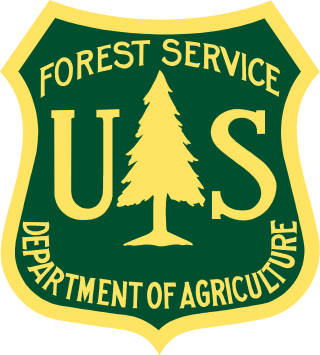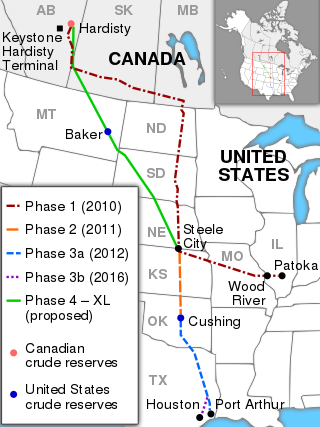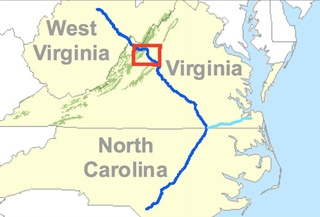
The United States Forest Service (USFS) is an agency within the U.S. Department of Agriculture that administers the nation's 154 national forests and 20 national grasslands covering 193 million acres (780,000 km2) of land. The major divisions of the agency are the Chief's Office, National Forest System, State and Private Forestry, Business Operations, as well as Research and Development. The agency manages about 25% of federal lands and is the sole major national land management agency not part of the U.S. Department of the Interior.

The Federal Energy Regulatory Commission (FERC) is an independent agency of the United States government that regulates the interstate transmission and wholesale sale of electricity and natural gas and regulates the prices of interstate transport of petroleum by pipeline. FERC also reviews proposals to build interstate natural gas pipelines, natural gas storage projects, and liquefied natural gas (LNG) terminals, in addition to licensing non-federal hydropower projects.

The National Environmental Policy Act (NEPA) is a United States environmental law designed to promote the enhancement of the environment. It created new laws requiring U.S. federal government agencies to evaluate the environmental impacts of their actions and decisions, and it established the President's Council on Environmental Quality (CEQ). The Act was passed by the U.S. Congress in December 1969 and signed into law by President Richard Nixon on January 1, 1970. To date, more than 100 nations around the world have enacted national environmental policies modeled after NEPA.
An environmental impact statement (EIS), under United States environmental law, is a document required by the 1969 National Environmental Policy Act (NEPA) for certain actions "significantly affecting the quality of the human environment". An EIS is a tool for decision making. It describes the positive and negative environmental effects of a proposed action, and it usually also lists one or more alternative actions that may be chosen instead of the action described in the EIS. One of the primary authors of the act is Lynton K. Caldwell.

The National Trails System is a series of trails in the United States designated "to promote the preservation of, public access to, travel within, and enjoyment and appreciation of the open-air, outdoor areas and historic resources of the Nation". There are four types of trails: the national scenic trails, national historic trails, national recreation trails, and connecting or side trails. The national trails provide opportunities for hiking and historic education, as well as horseback riding, biking, camping, scenic driving, water sports, and other activities. The National Trails System consists of 11 national scenic trails, 21 national historic trails, over 1,300 national recreation trails, and seven connecting and side trails, as well as one national geologic trail, with a total length of more than 91,000 mi (150,000 km). The scenic and historic trails are in every state, and Virginia and Wyoming have the most running through them, with six.
The Healthy Forests Initiative (HFI), officially the Healthy Forests Restoration Act of 2003, is a law proposed by President George W. Bush following the forest fires of 2002 which was devastatingly widespread. Its stated intent is to reduce the threat of destructive wildfires. The law seeks to accomplish this by allowing timber harvests on protected National Forest's land. The law streamlined the permitting process for timber harvests in National Forests by adding new categorical exclusions to the National Forest Service's list of categorical exclusions from the environmental impact assessment process.
The Forest and Rangeland Renewable Resources Planning Act of 1974(RPA) (16 U.S.C. §§ 1600 et seq.) is a United States federal law which authorizes long-range planning by the United States Forest Service to protect, develop, and enhance the productivity and other values of forest resources. RPA requires that a renewable resource assessment and a Forest Service plan be prepared every ten and five years, respectively, to plan and prepare for the future of natural resources. RPA was reorganized, expanded, and otherwise amended by the National Forest Management Act of 1976.

The Keystone Pipeline System is an oil pipeline system in Canada and the United States, commissioned in 2010 and owned by TC Energy and, as of March 2020, the Government of Alberta. It runs from the Western Canadian Sedimentary Basin in Alberta to refineries in Illinois and Texas, and also to oil tank farms and an oil pipeline distribution center in Cushing, Oklahoma.
The California Wilderness Act of 1984 is a federal law, passed by the United States Congress on September 28, 1984, that authorized the addition of over 3 million acres (12,000 km2) within the state of California to the National Wilderness Preservation System. Conservation activist George Whitmore later credited the Act with establishing "the longest stretch of de facto wilderness in the lower 48 states."
Union Hill is an unincorporated community in Buckingham County, Virginia, that was founded by freed slaves after the American Civil War.
Lyng v. Northwest Indian Cemetery Protective Association, 485 U.S. 439 (1988), was a United States Supreme Court landmark case in which the Court ruled on the applicability of the Free Exercise Clause to the practice of religion on Native American sacred lands, specifically in the Chimney Rock area of the Six Rivers National Forest in California. This area, also known as the High Country, was used by the Yurok, Karuk, and Tolowa tribes as a religious site.
Rosemont Copper is a proposed large open pit copper mine project by the Canadian mining corporation Hudbay Minerals. The project site is located within the Santa Rita Mountains and Coronado National Forest, in Pima County of southern Arizona. It has undergone a permitting review process under the direction of the United States Forest Service and the U.S. Army Corps of Engineers and has been delayed by legal judgements and suspension of its operating permit by the US Army Corps of Engineers.
Marvin Brandt Revocable Trust v. United States, 572 U.S. 93 (2014), was a United States Supreme Court case in which the Court held that a railroad right-of-way granted under the General Railroad Right-of-Way Act of 1875 is an easement. Therefore, when a railroad abandons such a right-of-way, the easement disappears, and the land owner regains unburdened use of the land.
California Coastal Commission v. Granite Rock Co., 480 U.S. 572 (1987), is a United States Supreme Court case addressing the question of whether United States Forest Service regulations, federal land use statutes and regulations, or the Coastal Zone Management Act of 1972, preempt the California Coastal Commission's imposition of a permit requirement on operation of an unpatented mining claim in a national forest. The court ruled that even if federal land is not included in the Coastal Zone Management Act's interpretation of "coastal zone," the act does not automatically preempt all state regulation of activities on federal lands.

The Atlantic Coast Pipeline was a planned natural gas pipeline slated to run 600 miles (970 km) from West Virginia, through Virginia, to eastern North Carolina. It was canceled in July 2020.

The Mountain Valley Pipeline (MVP) is a natural gas pipeline constructed from northwestern West Virginia to southern Virginia. The MVP is 303 miles (488 km) long, and there is also a proposed Southgate Extension which will run 75 miles (121 km) from Virginia into North Carolina. The completed pipeline has a capacity of 2 million dekatherms (Dths) of natural gas per day, with gas produced from the Marcellus and Utica shale formations.
The Southern Environmental Law Center (SELC) is the largest 501(c)(3) environmental nonprofit organization in the southeastern United States, with more than 100 attorneys and 200 staff members overall working at the local, state, and federal level. Headquartered in Charlottesville, Virginia, SELC has nine offices in six states: Alabama, Georgia, North Carolina, South Carolina, Tennessee and Virginia. The organization also has an office on Capitol Hill.
Equitrans Midstream Corporation, also known as E-Train, is an American energy company engaged in the pipeline transportion of natural gas and natural gas liquids. It is headquartered in Canonsburg, Pennsylvania, and is a wholly-owned subsidiary of EQT Corporation.
PennEast Pipeline Co. v. New Jersey, 594 U.S. ___ (2021), was a United States Supreme Court case dealing with the sovereign immunity of states to delegated powers of eminent domain granted to private companies from federal agencies, in the specific case, acquiring property for the right-of-way to build a natural gas pipeline. The Court, in a 5–4 decision issued in June 2021, ruled that states, by nature of ratifying the Constitution, gave up their ability to exercise sovereign immunity from the federal government or from those parties whom they have delegated that authority.








